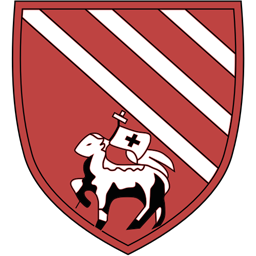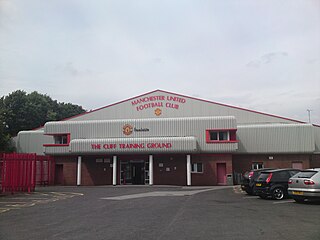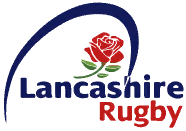
Droylsden Football Club is a football club in Droylsden, Greater Manchester, England, that last played in the Northern Premier League Division One North West, the eighth tier of English football.

Broughton is a suburb and district of Salford, Greater Manchester, England. Located on the east bank of the River Irwell, it is 1 mile (1.6 km) northwest of Manchester and 2 miles (3.2 km) south of Prestwich.
Broughton Rangers were one of the twenty-one rugby clubs which met at the George Hotel, Huddersfield, in 1895 to form the Northern Rugby Football Union. They were originally based in Broughton, Salford, but in 1933 moved to Gorton, Manchester to play at the Belle Vue Stadium, and were renamed Belle Vue Rangers in 1946. The club folded in 1955.
Manchester City and Manchester United are popular Premier League football clubs in Greater Manchester. United's ground is in Old Trafford; Manchester City's home ground is the City of Manchester Stadium in east Manchester. Fixtures between the clubs are referred to as the Manchester Derby. Manchester United are historically the most successful football club in England with 66 elite honours won.

The Cliff is a sports ground in Broughton, Salford, England, on the banks of the River Irwell, that was rugby league club Broughton Rangers' home ground until 1933. It was purchased by association football club Manchester United for use as their training ground. It was used as the club's primary training facility until 1999, when it was replaced by the Trafford Training Centre in Carrington, though it continues to host some Manchester United academy matches. It is also sometimes used by Salford rugby league side as a training venue.
Stanley "Stan"/ "Mac" McCormick was an English professional rugby league footballer who played in the 1940s and 1950s, and coached in the 1960s and 1970s. He played at representative level for Great Britain, England and Lancashire, and at club level for Broughton Rangers/Belle Vue Rangers, Oldham RLFC, Huddersfield, St. Helens and Warrington, with whom he won the 1953–54 Challenge Cup, as a wing, i.e. number 2 or 5. and coached at club level for St. Helens and Salford. McCormick is a St Helens R.F.C. Hall of Fame inductee.
Elwyn Gwyther was a Welsh rugby union and professional rugby league footballer who played in the 1940s and 1950s. He played representative level rugby union (RU) for Wales XV, and at club level for Llanelli RFC, as a prop, i.e. number 1 or 3, and representative level rugby league (RL) for Great Britain and Wales, and at club level for Belle Vue Rangers and Leeds, as a prop.
Thomas Blinkhorn was an English professional rugby league footballer who played in the 1920s and 1930s. He played at representative level for Great Britain and England, and at club level for Wigan Highfield, Warrington and Broughton Rangers, as a fullback, or wing.
Terrence Flanagan MBE is an English former professional rugby league footballer who played in the 1970s and 1980s, usually as a loose forward. He played at representative level for Great Britain and Lancashire, and at club level for Oldham.
William Watkins was a Welsh rugby union, and professional rugby league footballer who played in the 1930s and 1940s. He played club level rugby union (RU) for Cross Keys RFC, and representative level rugby league (RL) for Great Britain and Wales, and at club level for Salford and wartime-guest at Oldham RLFC, as a scrum-half.
George Ruddick was a Welsh rugby union, and professional rugby league footballer who played in the 1890s, 1900s and 1910s. He played club level rugby union (RU) for Brecon RFC, and representative level rugby league (RL) for Great Britain, Wales, and Lancashire, and at club level for Broughton Rangers, as a forward.
The 1901–02 Northern Rugby Football Union season was the seventh season of rugby league football run by England's Northern Rugby Football Union. A number of off-season changes made this season different from preceding ones. In June 1901 fourteen leading clubs from both Lancashire and Yorkshire resigned from their respective senior competitions to form a new Northern Rugby Football League.
The 1946–47 Rugby Football League season was the 52nd season of rugby league football.

The Lancashire County Rugby Football Union is the society responsible for rugby union in the county of Lancashire, England, and is one of the constituent bodies of the national Rugby Football Union having been formed in 1881. In addition it is the county that has won the County Championship on most occasions

Broughton Rugby Union Football Club is a rugby union club based in Salford, Greater Manchester, which at the time of the club's founding in 1869 was in Lancashire, England. Its home venue is the Broughton Cricket & Rugby Club pitch on Yew Street. Broughton, although it currently occupies a low position in the English rugby union league system, is notable for its early important contributions to the development of rugby union most predominantly in the north of England, but also nationally. Broughton also hosted the first ever rugby match played under floodlights.
The 1940–41 Northern Rugby Football Union season was the second season of the English rugby league’s Wartime Emergency League necessitated by the Second World War. After doubts that the season might not start, matches were played in a league organised in a similar way to the previous season with two regional leagues, Yorkshire and Lancashire, with the winners of each league meeting in a two-legged play-off final to determine the overall champions.
The 1931–32 Lancashire Cup was the twenty-fourth occasion on which the Lancashire Cup competition had been held. Once again a new name was to be added to the trophy this year as it was the turn of Salford, who won the trophy for the first time by beating neighbours and close rivals Swinton in the final by 10-8.
1936–37 was the twenty-ninth occasion on which the Lancashire Cup completion had been held.
Salford won the trophy by beating Wigan by 5-2
The match was played at Wilderspool, Warrington, now in the County Palatine of Chester but (historically in the county of Lancashire. The attendance was 17,500 and receipts were £1,160.
This was the third of the three consecutive Lancashire Cup finals in which Salford would beat Wigan
The 1939–40 Northern Rugby Football League season was an emergency season of English rugby league fixtures necessitated by the outbreak of the Second World War. The regular league season had started at the end of August 1939, but on the outbreak of war all sport was suspended. When government permission for sport to be resumed was given, the league was reorganised into two regional competitions, Yorkshire and Lancashire. The winners of each league playing against each other to decide the overall champions. The Yorkshire competition was won by Bradford Northern who beat Swinton, winners of the Lancashire competition, in the two-legged league final.





